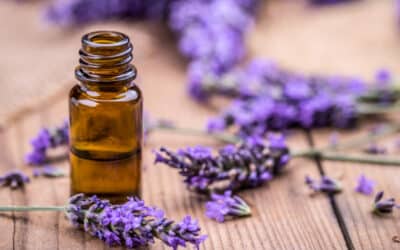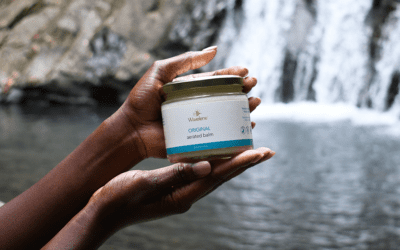Who doesn’t love baby skin? That smooth, silky soft texture we wish we could maintain into adulthood… or do we?
Baby skin is magical, but that’s because it hasn’t been conditioned to the elements of the outside world, a process which takes at least a year.
During that time, a baby’s skin barrier (which is a nubile organ, after all) is 30% thinner than an adult’s. This makes it more susceptible to infection, temperature changes, and irritation. It also means it loses moisture about twice as fast, which is why baby skincare is just as important as what you feed your baby.
But just how do we properly care for baby skin?
The short answer is: with the cleanest and safest ingredients possible.
Baby skin is also a critical component of the immune system, and there are correlations between exposure to harmful ingredients at a young age and chronic sickness later in life.
That’s why organic baby products should always be your first choice where possible. But before you get fussy, let’s dive into what ingredients to avoid and what ingredients to look out for in organic baby skincare products.
What To Avoid In Baby Skincare
Before we talk about the ingredients you want to see on the label, let’s goo-goo over ones you definitely don’t.
Petroleum jelly has been used in moisturizing products for ages, but it’s time we ALL steer clear of this filler, not just us mommas.
Hence Waxelene’s “The Petroleum Jelly Alternative”, now their Multi-Purpose Ointment.
Petroleum jelly is an occlusive agent, it coats your skin and seals in whatever is already there. The skin doesn’t actually absorb any moisture or nourishment. On the one hand, that’s good because it’s an oil byproduct, but bad when you consider it means it’s a superficial solution that only provides temporary relief to dryness.
For children and babies, inhaling or ingesting (and we all know babies put everything in their mouths) the chemicals and carcinogens found in petroleum jelly can be especially problematic and lead to allergies and even pneumonia.
Water is another common ingredient in moisturizing products, despite the fact that it’s one of the top 3 causes of baby dry skin.
Water may seem innocuous enough, but infant skin has a higher rate of water absorption than adult skin. A higher absorption rate of a dehydrating ingredient: need we say more?
Other common ingredients to avoid include alcohol, phenoxyethanol, parabens, sulfates, and SLS (or anything sodium-related, as it’s far too abrasive for baby skin). Thankfully, the latter aren’t found in skincare products as much, but still worth keeping an eye out especially when shopping for organic baby shampoo.
The Best Ingredients For Baby Skin
Three natural skin care ingredients lie at the forefront of both Waxelene’s baby products: beeswax, soy oil, and vitamin E.
For good reason, too!
Parents are buzzing about beeswax. Just as beeswax protects the precious honeycombs within a beehive, it protects the skin by keeping infection out and sealing moisture in. It’s abundance of vitamin A also provides healing properties and at the same time, it boasts antiviral, antibacterial, and anti-inflammatory properties.
If your little one has known bee allergies, fear not; beeswax is 100% safe and allergen-free.
You may be familiar with soy from your vegan diet, but have you ever heard of soy oil?
If not, we’ll let you in on a not-so-secret: it’s amazing for the skin, as it contains both Omega-3 and Omega-6 fatty acids and isoflavone genistein. The latter stimulates collagen production repairing dry and damaged skin at the cellular level.
Dry skin happens when skin isn’t producing enough natural oil to stay hydrated. Hence why vitamin E is yet another fabulous ingredient for healthy baby skin, as it helps promote the development of the skin barrier and the production of natural oils.
You can either look for vitamin E on its own (as in Waxelene products) or for vitamin E-rich ingredients such as sunflower seed oil, which is a natural emollient also rich in antioxidants.
Fortunately, you’ll find all three ingredients in both Waxelene’s Calming Ointment and Multi-Purpose Ointment.
Bonus: If you’re trying to raise a zero waste baby, you can even opt to order these in a glass jar.
More baby skin-safe ingredients to look for outside Waxelene’s chosen ingredients include shea butter, coconut oil, honey, yogurt, papaya, almond oil, and avocado oil.
Skin Care Ingredients for Baby Eczema
Eczema is one of the most common skin conditions, affecting about 25% of children. According to the American Academy of Dermatology Association, 60% of those develop it in the first year of life.
While there is no cure, it can be soothed and managed with the right treatment.
Eczema is a result of a lot of potential factors. Exposure to chemicals is one (more reason to play it safe with baby products).
Skin pH is another and baby skin has a higher pH than adult skin. Quick chemistry lesson: the higher the pH, the more alkaline something is, and in the case of skin, alkalinity means dryness.
This is why extra virgin olive oil (ideally organic and unrefined) is one of the best ingredients for baby eczema. Rich in healthy fats and linoleic acid, it’s particularly suited for balancing skin pH while simultaneously rebuilding the skin’s moisture barrier.
Its anti-inflammatory and anti-bacterial properties soothe scaly patches while polyphenols and phytosterols prevent further irritants from sticking to the skin. It also contains numerous vitamins and an antioxidant-rich organic compound known as squalene which promotes cell regeneration.
While synthetic fragrances are bad for babies, natural essential oils can be helpful in combating eczema.
Organic lavender oil and rosemary oil, like those found in the Calming Ointment, both reduce inflammation and eliminate bacteria-causing eczema. Lavender oil also stimulates collagen production so the skin can repair itself.
Skin Care Ingredients for Baby Rashes
Babies can get rashes for a whole host of reasons: heat, allergies, friction, moisture, chemicals and fragrances, and bacterial or viral infections.
While skincare can’t always solve these causes, parents can safely soothe a rash with ingredients like colloidal oatmeal, which reduces itching and restores the skin moisture barrier.
Aloe vera is another excellent solution, with the ability to soothe and heal not only rashes, but abrasions, cuts, and itchy insect bites.
Zinc oxide can also be used to create a protective barrier for baby skin in the diaper region and aids the production of new tissue. However, it must be limited to 25% concentration at most and be formulated with non-nano particles (just like in your favorite zero waste sunscreen) to prevent absorption of dangerous minerals.
Final Thoughts on Baby Skin Care Ingredients
It’s only natural that we want the best for our precious little ones.
That means ensuring everything they come into contact with, from organic baby toys to organic baby clothes or organic baby blankets, is safe and chemical-free—especially things that will be absorbed into that magically soft skin.
Baby skincare safety is a necessary part of early parenthood. Instead of letting all those unpronounceable ingredients make you scream just like your infant, look for products formulated with baby-safe ingredients.





0 Comments